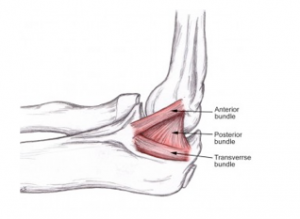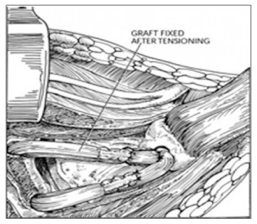Ulnar Collateral Ligament Injury
Description:
The ulnar collateral ligament (UCL) is one of the main ligaments in the elbow. The UCL connects the arm bone (humerus) to one of the forearm bones (ulna). It functions as the main stabilizer of the medial aspect of the elbow.
Injuries to the UCL most commonly occur in overhead throwing athletes, such as baseball players (especially pitchers), football quarterbacks, and javelin throwers. During the overhand throwing motion, tremendous forces are placed across the elbow, and much of this force is transmitted through the UCL. Overuse may lead to small micro-tears in the UCL. Ultimately this repetitive micro-trauma may cause failure of the ligament. Occasionally, athletes report one specific throw which completes the injury; this throw is associated with a pop in the elbow and subsequent pain and swelling.
Injuries to the UCL may also occur following severe elbow trauma in which an elbow dislocation is sustained.
Signs & Symptoms:
Typically patients report significant pain on the inside aspect of the elbow. Pain is usually reported only with throwing-type activities. Most patients have no pain at rest or with activities of daily living. Baseball pitchers frequently report loss of control and decreased velocity.
Diagnosis:
The diagnosis of a UCL tear is typically made by a combination of the patient’s history, the findings on physical examination, and an MRI scan.
Treatment:
Initial treatment of UCL injuries involves non-operative measures including refraining from throwing activities, icing, anti-inflammatory medications, and a 6 week course of physical therapy. After this time, a throwing protocol is recommended as the athlete attempts to return to their sport.
If these initial measures are unsuccessful, most providers recommend repeating a course of rest, activity modification, anti-inflammatory medications, and physical therapy followed by a second attempt at a throwing program. At this point if the athlete is unable to successfully return to their sport, surgical reconstruction of the UCL is recommended.
Surgical treatment involves harvesting a tendon either from the forearm or hamstring region of the knee to recreate a new ulnar collateral ligament. The tendon is weaved into and out of the bone tunnels in the humerus and ulna respectively to recreate the anatomy of the UCL.
Following surgery, there is a lengthy post-operative rehabilitation protocol which is necessary for optimal outcomes to be achieved. Athletes can expect to return to their sport no sooner than 12 months, but up to 18 months, from the time of surgery.
Hear Dr. Adam Farber Discuss UCL Injuries and Treatment:
